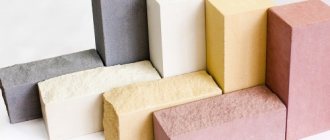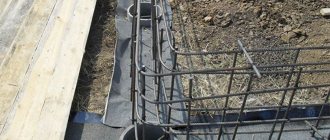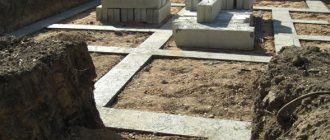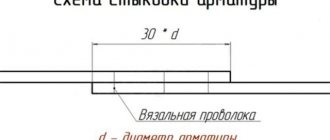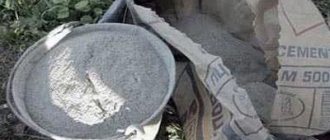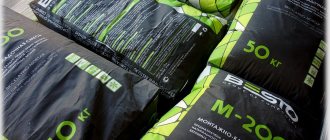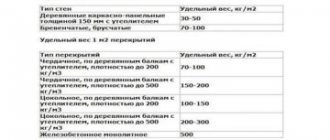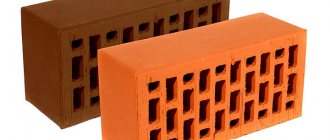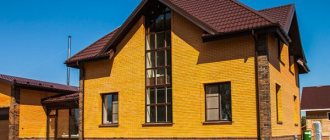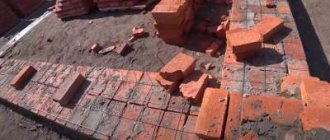How to correctly calculate the amount of building materials to build a house
Brick is considered the most popular building material in the construction of both residential and non-residential buildings.
Before starting the construction process, it is necessary to carry out a preliminary calculation to understand how much brick will be needed. This is done in order to avoid unnecessary costs and eliminate the possibility of a shortage of building materials during construction. However, before proceeding with the calculations, it is necessary to take into account several points, namely:
- Type of brick;
- The masonry method is selected depending on the desired thickness of the future walls;
- The area of walls, as well as door and window openings.
Dimensions of different types
There are these types of material:
- ceramic;
- clinker;
- hyper-pressed;
- silicate.
Dimensions may vary depending on the type of product.
Standard dimensions of material according to GOST
Ceramic
The dimensions of facing ceramic bricks are standard. The structure of the finished stone is homogeneous or with voids. It is breathable and moisture resistant.
Its advantages include:
- soundproofing properties;
- withstands strong temperature fluctuations;
- fire safety;
- resistance to loads;
- ease of installation.
The finished product has a uniform color. There are no cracks or chips on the surface. A popular color used for decoration is yellow and its shades. The sizes of yellow facing bricks are standard and do not differ from the others.
Disadvantages include:
- high price;
- the material becomes brittle due to violation of production technology.
Clinker
Clinker brick has high strength properties. Made from special clay, the product is molded and fired at elevated temperatures. The finished material comes with internal hollow holes and solid.
Advantages:
- does not fade;
- moisture resistant;
- thermal insulation properties;
- resistance to constant temperature fluctuations;
- mechanical strength;
- long service life.
Due to its strength properties, the material is widely used in construction. It is used for: courtyards, doorways, basements, paths near a pond or pool. The most commonly used colors are red and beige for decoration. The dimensions of facing red brick are standard 250x85x65 mm, thin 250x60x65 mm are also used.
The disadvantages include:
- does not absorb water.
- weight.
- price.
Standard dimensions of clinker products are 240x115x71 mm. Installation is a rather labor-intensive process and requires additional skills and auxiliary materials; it is better to entrust this work to specialists.
Hyper-pressed
Hyper-pressed bricks are produced through the process of semi-dry hyper-pressing. The product is made from environmentally friendly materials such as shell rock and limestone. Dyes are added during production, resulting in products with a wide range of colors. The finished product has a non-standard relief.
Advantages of the material:
- exact dimensions;
- frost-resistant.
This material is often used for cladding both single-story and multi-story buildings.
Flaws:
- cracks appear under the influence of temperature;
- fades when exposed to sunlight;
- weight.
Standard parameters of finished products are 250×120×65.
Silicate
Sand-lime facing brick is produced through the pressing process. For production they use: sand, limestone and water. The proportions of the composition are carefully observed; due to their violation, low-quality materials are obtained.
Advantages of the material:
- ecologically pure;
- soundproofing properties;
- price;
- simple installation process.
Finished products have clear geometric parameters. Sand-lime facing brick is frost-resistant and is used for both internal and external finishing work.
Disadvantages include:
- moisture permeability;
- thermal conductivity;
- weight.
Also, this brick has a small palette of colors, in which it is inferior to other types. Dimensions depend on the type. Standard parameters 250×120×65.
Concrete facing brick
To make concrete bricks you need: granite screenings, cement and water. The ingredients are mixed and shaped, then left to harden. Due to the ease of production, the cost of finished products is low.
Standard dimensions: 250x60x65 mm, 250x90x65, 250x120x65 mm. Manufacturers can also produce products with other parameters.
The advantages include:
- price;
- ease of installation;
Concrete facing brick has high strength characteristics and is resistant to the external environment.
Flaws:
- cracks occur if the production technology was poorly followed;
- weight.
The material is not inferior in its strength qualities to other types. It has a large palette of colors from bright to pastel and looks good on facades.
Combined brick
One of the most unusual and popular types is combined brick. It has good strength properties and is resistant to external factors. The cost of this material is high.
This type has a difference in texture and color, the most common of which are wood or metal. It embodies several types of bricks at once. It is used for external and internal work. Most often used for: building facades, decorating fences and stairs, flower beds, borders on paths.
Handmade brick
The production of handmade bricks is mainly carried out by European companies. This material comes in many colors and different sizes. The manufacturer can “control” the properties of the material and, using the composition, set the necessary parameters. The cost of such products is high. Each batch is produced in limited quantities.
Most often used for restoration work. Used for ancient castles, churches, chapels.
Figured (shaped) brick
One of the most popular types is figured brick. Finished products have different shapes and dimensions. The range of colors is also wide. With the advent of shaped bricks, builders no longer need to hew and cut elements of a suitable size and shape from ordinary rectangular bricks. Thanks to such products, any building can be decorated in an unusual and elegant way. This material is convenient for finishing columns, pillars, door and window openings.
The cost of shaped products is higher than regular rectangular ones. This is due to production costs.
Main types of bricks and methods of laying them
In accordance with GOST, the size of an ordinary brick must be the same length and width (25x12 cm).
Only the thickness can differ:
- Single – 0.65 cm;
- For one and a half - 0.88 cm;
- Double – 1.38 cm.
Advice: The most aesthetically pleasing walls are those that were built from single bricks. However, the use of one-and-a-half and double bricks significantly speeds up and facilitates the construction process. In addition, the consumption of masonry mortar is reduced.
The masonry method directly affects the thickness of future walls.
Masonry is of the following types:
- Half a brick (thickness 12 cm);
- In full brick (thickness 25 cm);
- One and a half bricks (thickness 38 cm);
- In two bricks (thickness 51 cm);
- Two and a half bricks (64 cm).
Advice. Taking into account the characteristics of climatic zones, the most optimal solution would be to lay walls of two and two and a half bricks.
Choosing a brick
The calculations do not cause any particular difficulties; they consist of several simple mathematical operations. True, appropriate measurements should be taken, the accuracy of which determines the final result.
The accuracy of calculating the amount of brick depends on the correctness of the measurements.
First of all, the type of brick stone planned for construction work is determined. Let's look at the main types of bricks.
Made from unfired clay
In addition to the main component used for the manufacture of such bricks, fillers are used in the form of cut straw, reeds, shavings, etc. For production, an artisanal technique is used:
- clay is mixed with fillers;
- stones are formed from the resulting raw materials;
- The drying process is organized under sunlight.
The organic filler acts as reinforcement, preventing the stone from collapsing during construction work and throughout the entire operational period. The main advantage of this material used to build a house is its reasonable cost and availability of manufacturing, which can be organized directly on the construction site on your own. Unfortunately, due to an imperfect technological process, the brick strength indicator leaves much to be desired, and, in accordance with current SNiPs, is not used for the construction of large objects. This type of brick is not suitable for the construction of two-story or higher buildings, but it is quite suitable for outbuildings.
Refractory
For production, a special grade of clay of a yellow hue is used - fireclay. Often mineral components of large fractions are added to the brick, which gives the surface of the stone a grainy appearance. The material is able to withstand elevated temperatures for a long time, reaching one and a half thousand degrees Celsius, which allows it to be used for arranging stoves, chimney ducts, fireplaces, and thermal insulation screens. The cost of bricks made from refractory clay is high, which makes its use for the construction of walls economically unprofitable.
Silicate
The basis of such stone is lime and silicate components, which explains the poor tolerance of exposure to a humid environment. Stones of a light gray shade are formed by pressing, are not subjected to subsequent firing, and are not used for the construction of structures that require operation in conditions of high humidity.
Ceramic
A common type of solid brick material used in the construction of load-bearing walls. It is made from pressed clay and fired under a certain temperature.
Such bricks are divided into three groups:
- private. Solid stone used in the construction of facades, laying opening sections of monolithic structures, etc. Withstands significant load impacts, resistant to external aggressive factors. The masonry does not have high aesthetic qualities and requires subsequent decorative finishing;
- facing. Like the previous type, facing stone is a decorative variety. It is used for finishing walls, erecting fences, gazebos and other structures. One or two of its surfaces are glossy, a significant part of the internal volume is occupied by void areas created by molding presses and increasing the degree of adhesion between the brick and the masonry mortar;
- clinker. The material has a high density, glossy surface, and is used for the construction of small architectural structures and flooring. It has one significant drawback - the high price.
Calculation of the amount of building material
When calculating, two methods are often used. In one, calculations are carried out taking into account the mortar joint, and in the second they are not taken into account. Typically its thickness ranges from 5 to 10 mm.
It is important to know! If the second method is used in the calculation, there is a chance of obtaining an excess of building materials, approximately 30%. The first method is more economical, but it also has its pitfalls. 10-15% should be added to the resulting amount of material. These percentages take into account possible brick breakage during construction.
For better understanding, let's look at an example.
It is necessary to build a one-story brick house with the following dimensions:
- Length – 12 m;
- Width – 10 m;
- Height – 4 m.
The calculation is carried out only taking into account external walls. They have one door (1x2 m) and three window (1.2x1.5 m) openings.
Brick type: regular single.
Laying method: two bricks.
Mortar joint: 7 mm.
So, calculating the amount of building materials for the construction of the specified house using the first method should look like this:
First you need to determine the perimeter of the external walls (1). Then you can calculate their area (2). Next you need to calculate the area of the openings (3). Now you can calculate the area of the masonry itself (4). The next step will be to determine the amount of building material per 1. To do this, you need to calculate the area of the frontal surface of the brick (5) and divide the resulting value by 1 (6), and then multiply by 2, since in our case the laying is carried out in two bricks (7). Total: 256 bricks per 1.
Result: to build the walls of a house according to the above parameters, you will need 31,898 bricks.
To calculate the amount of building material using another method, you need to add the thickness of the seam to the size of the brick, in our case it is 7 mm (9). From this it turns out that the number of bricks per 1 will be 219 pieces (10). Now we multiply this amount by the total area of the masonry (11), additionally adding the amount of material for scrap (1500-2000 pieces) and we get approximately 28,800-29,300 pieces.
Calculations:
- Рн= (12+10)х2=44 m.
- Sc=44x3=132 m^2.
- Sp=(1x2)+(1.2x1.5)x3=7.4.
- Sk=132-7.4=124.6.
- 0.12x0.065=0.0078.
- 1/0,0078=128.
- 128x2=256.
- 124.6x56=31897.6
- (0.12+0.007)x(0.065+0.007)=0.009144.
- 1/0.009144x2=218.723.
- 219xSk=219x124.6=27287.4.
Having analyzed both calculation options using an example, you can see that the first method is more economical.
Features of calculations
In order to avoid mistakes and correctly calculate the number of porous or other bricks for walls of 150 square meters. m or other area, you need to know the exact dimensions of the stone. As a rule, novice developers make mistakes and end up with more building material than is actually needed.
The main mistake is that suture areas are not taken into account. The fact is that layers of mortar mixture provide an impressive volume, reaching almost twenty percent of the total value.
It is generally accepted that the average seam value is seven millimeters. Having specified the parameters of the brick stone, it is easy to determine that for one cubic meter of masonry, twenty to thirty percent of the volume falls on the masonry mixture. For clarity, let's look at an example.
It has been practically proven that per cubic meter of masonry it is necessary:
- single stone – 512 pcs.;
- one and a half - 378 pcs.;
- double – 242 pcs.
Taking into account the volume of the mortar mixture, the given values will be reduced and amount to 394, 302 and 200 products, respectively. To determine how many bricks are needed for a house of 100 square meters. m or another building, you can use one of the existing methods.
The first method involves taking into account not standard parameters, but dimensions with allowances for the thickness of the masonry joint. In the second case, the calculation is based on the average amount of building material for each square of masonry. It is more optimal and produces accurate results with an error not exceeding three percent.
For convenience, many use the brick stone consumption table:
| Type of material per 1 m2 with seams | Half a brick, pcs. | In one brick | One and a half stone | Two bricks | For thick walls |
| single | 51 | 102 | 153 | 204 | 255 |
| thickened | 39 | 78 | 117 | 156 | 195 |
| double | 26 | 52 | 78 | 104 | 130 |
Calculation of the required amount of bricks
Calculation of the amount of bricks can be carried out in two main ways:
- Does not take into account the thickness of the mortar joint.
- Taking into account the thickness of the seam, which is usually from 5 to 10mm.
It should be borne in mind that when using the first method, there may be an excess of building materials by 25-30%. The second method is more economical, but it is necessary to add 10-15% to the calculated value to take into account possible brick breakage during construction.
For clarity, let’s carry out the calculation using a specific example: It is necessary to build a one-story brick house 8 by 10 m, with a wall height of 3 m and without internal brick walls. In the external walls there is one opening for the entrance door 1 by 2 m and three openings for windows 1.2 by 1.5 m. The thickness of the walls is two bricks from a standard single brick with a joint thickness of 5mm.
The calculation procedure for the first method will be as follows:
- We determine the perimeter of the external walls: (8+10)*2=36m.
- We determine the total area of the walls of the house: 36*3=108 sq.m.
- We determine the total area of door and window openings: (1*2)+(1.2*1.5)*3=7.4 sq.m.
- We calculate the area of the brickwork of the walls: 108-7.4 = 100.6 sq.m.
- We determine the amount of brick in one square meter, for which we calculate the end area of one brick: 0.12*0.065=0.0078 and divide this value by one: 1/0.0078=128, after which we multiply by two (since the masonry will be 2 bricks). We get 128*2=256 bricks per 1 sq.m.
- We calculate the required number of bricks for building a house by multiplying the total area of the walls without taking into account openings by the number of bricks in 1 sq.m: 100.6*56=25753.6.
Thus, 25,754 bricks will be needed to build the walls of the house.
Carrying out the calculation using the second method, to determine the amount of brick in 1 sq.m, we add 5 mm to the standard brick dimensions (joint thickness): (0.12+0.005)*(0.065+0.005)=0.00875. Accordingly, the amount of brick in 1 sq.m will be: 1/0.00875*2=229 bricks. Multiplying this number by the total area of the masonry we get: 229*100.6=23037.4. Let's add to this value about 1500-2000 bricks per battle and we get the amount of bricks needed to build a house: approximately 24,500-25,000 bricks.
From the above example it can be seen that the second calculation method is more economical.
The calculation for other wall thicknesses is carried out similarly, taking into account the appropriate corrections. If you need to calculate the number of foam blocks per house , see this article.
How many bricks are in the masonry: table
During the work, the most unpleasant moment is considered to be a lack of material and additional financial expenses associated with transportation after additional purchase. Of course, the ideal option is to purchase and deliver the necessary bricks at one time.
Many construction sites have come to the rescue and have developed an online calculation calculator that helps calculate the exact amount of material for masonry. So, it allows you not only to determine the number of bricks in 1 m2 of masonry, but also to calculate the total number of pieces for the entire wall area. The calculator also calculates bricks for masonry, taking into account its size, the type of masonry itself, and also taking into account seams or without them. All you have to do is enter the appropriate data and in two to three seconds you will receive the calculation result. In any case, to determine the amount of building material required, you can use the data given in the table:
Calculating the amount of brick required per 1 m2 is actually not a difficult task. You only need to know the thickness of the masonry, the dimensions of the brick block, and the area of the walls being erected. Next, you can use either a calculation calculator or look at the value in the table. But even in this case, it must be remembered that any building material, especially in large quantities, contains defects. As for brick blocks, defects account for about 4-6% of the total quantity, so the purchase should certainly be made with a reserve.
Using online calculators for calculations
If you don’t want to do mathematical calculations, then to quickly calculate the required amount of bricks to build a house, you can use a free online calculator.
By entering the parameters of your future home into the appropriate fields, you can instantly get the desired result. In addition to calculating the required amount of brick, many online calculators allow you to simultaneously calculate other useful parameters, for example, the required amount of mortar for laying walls.
General information on the calculation results
- Building perimeter
– The total length of all walls taken into account in the calculations.
- Total masonry area
– The area of the outer side of the walls. Corresponds to the area of the required insulation, if provided for by the project.
- Wall thickness
– Thickness of the finished wall, taking into account the thickness of the mortar joint. May differ slightly from the final result depending on the type of masonry.
- Quantity
– The total number of bricks required to build walls according to the given parameters
- Total material weight
– Weight of bricks excluding mortar and masonry mesh. Just like the total volume, it is necessary to select a delivery option.
- Quantity of mortar for the entire masonry
– The volume of mortar required to lay all the bricks. The volumetric weight of the solution may differ depending on the ratio of components and additives introduced.
- Number of flexible links
– Necessary for attaching the facing layer to the main load-bearing walls. The length of the flexible connections depends on the total thickness of the wall, taking into account the insulation.
- Number of rows in masonry including seams
– Depends on the height of the walls, the size of the material used and the thickness of the masonry mortar. Excluding gables.
- Quantity of masonry mesh
– The required amount of masonry mesh in meters. It is used to reinforce masonry, increasing the solidity and overall strength of the structure. Pay attention to the number of reinforced rows; by default, the reinforcement of every third row is indicated.
- Approximate weight of finished walls
– The weight of the finished walls, taking into account all bricks, mortar and masonry mesh, but excluding the weight of insulation and cladding.
- Load on the foundation from the walls
– Load without taking into account the weight of the roof and ceilings. This parameter is necessary to select the strength characteristics of the foundation.
Types of bricks for construction
First of all, bricks are divided into two large groups depending on the material of manufacture:
- ceramic;
- silicate.
Red ceramic brick is based on high-quality clay with a minimal amount of impurities. After molding, it is fired in ovens at temperatures from 1000 to 1300 degrees.
Sand-lime brick consists of quartz sand and lime. After pressing, it is exposed to water vapor at a temperature of 170-200 degrees and a pressure of 8-12 atmospheres. Also, various impurities are often added to it, for example, titanium dioxide allows you to maintain the snow-white color of the product for decades.
It is also important for us to know what they can be depending on the content:
- full-bodied;
- hollow.
From the name it becomes obvious that solid brick does not have cavities. It is the most durable and is used for the construction of load-bearing walls. The void ratio is extremely small, for ceramic brick it is 5%, for silicate brick – 12%.
Hollow bricks contain two or more holes inside, which are used to retain heat and increase sound insulation. The void ratio can reach 40%. They are used to create partition walls or as cladding.
The last characteristic we are interested in is the size of the brick. According to GOST 530-2012, ceramic bricks are divided into nine different standard sizes (SF), and silicate bricks according to GOST 379-2015 are divided into five. Only three of them are particularly popular in Russia:
- single (1 NF) 250x120x65 mm;
- one and a half (1.4 NF) 250x120x88 mm;
- double (2.1 NF) 250x120x140 mm.
Two more types of blocks are also widely used:
- euro (0.7 NF) 250x85x65 mm;
- modular (1.3 NF) 288x138x65 mm.
What size blocks to use during construction is up to everyone to decide for themselves. There are no structural differences; the house will be equally strong if it consists of both double and single bricks. The aesthetic component is fundamental most people prefer the classic single brick.
The only objective point that is really worth paying attention to is the construction time and the price of materials. As a rule, one-and-a-half and double bricks are cheaper, and the amount of cement mortar required for installation is also reduced. And due to the larger size of the blocks, less time is required to construct the structure.
Brick sizes
To calculate the number of brick products in one cubic meter, you should clarify which of them are taken for masonry. According to GOST 8691-73, 3 types of brick sizes are produced:
- single solid (1) – 250 mm x 120 mm x 65 mm; used for the construction of foundations, the construction of external walls and internal partitions, the construction of fences, sheds, garages; its dimensions are convenient for alternating longitudinal and transverse rows;
- one and a half (1.5) – 250 mm x 120 mm x 88 m; used to speed up the installation of buildings;
- double (2.0) – 250/120/138 mm; allows you to double the thickness of the wall, however, due to its low strength, this material is not used when laying the foundations and first floors of high-rise buildings.
In addition to GOST products, bricks according to technical specifications (TU), facing, and hand-molded bricks are produced. Before calculating their cubic capacity, you should measure the length, width and height of the product.
